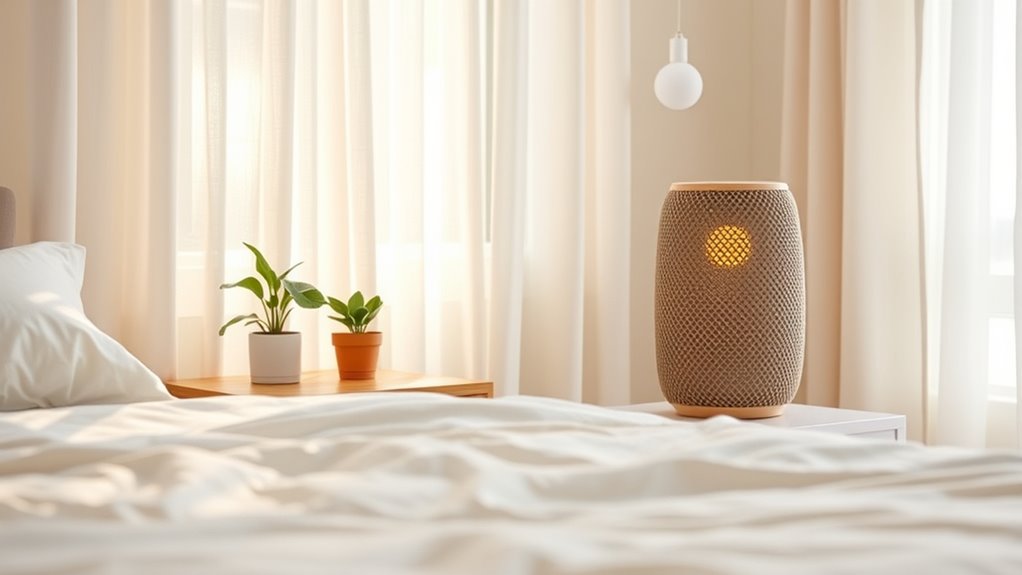To reduce bedroom allergens, start by using hypoallergenic mattresses and washing bedding weekly in hot water. Keep humidity levels between 40-50% to discourage mold and dust mites, and regularly vacuum with a HEPA filter. Use air purifiers and improve ventilation to clean the air, while minimizing carpets and heavy fabrics. Incorporate natural remedies like essential oils or potted herbs to enhance air quality. If you want to discover more effective tips, keep exploring these strategies.
Key Takeaways
- Use hypoallergenic bedding, allergen-proof covers, and wash all linens weekly in hot water to reduce dust mites and allergens.
- Maintain indoor humidity between 40-50% to inhibit mold growth and dust mite proliferation.
- Regularly clean with HEPA vacuum cleaners and keep clutter to minimize dust accumulation.
- Incorporate natural air purifiers like HEPA filters, essential oils, and potted herbs to improve air quality naturally.
- Choose allergen-resistant furniture, minimize fabric surfaces, and keep the bedroom clutter-free for a healthier sleep environment.
Identifying Common Bedroom Allergens
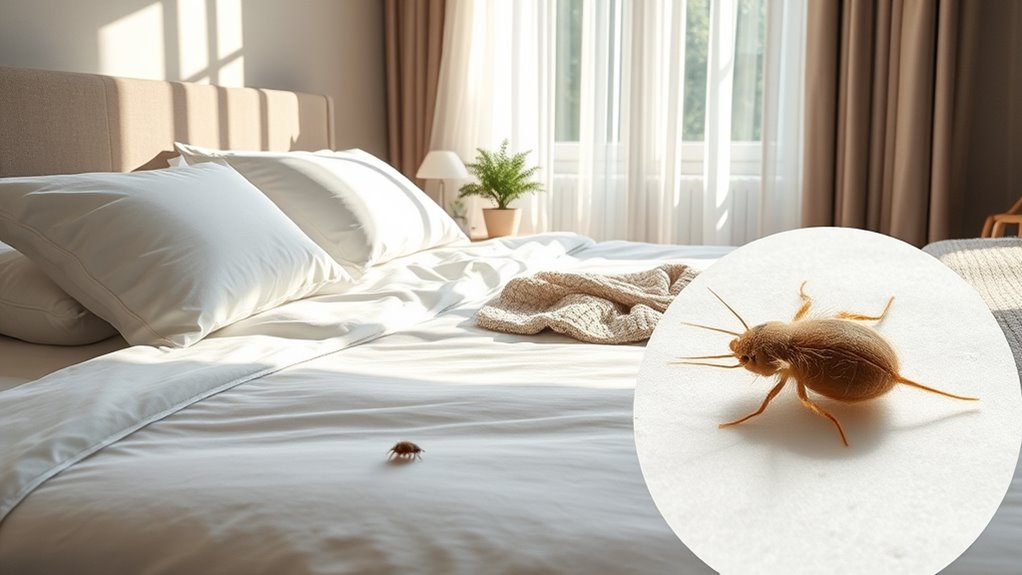
Have you ever wondered what might be triggering your allergies while you sleep? The first step is identifying common allergen sources in your bedroom. Dust mites, pet dander, mold spores, and pollen often hide in bedding, carpets, and curtains. To pinpoint what’s bothering you, focus on symptom identification—notice if you wake up sneezing, stuffy, or itchy. These signs can help you connect specific allergens to your reactions. Check for visible mold in damp areas and inspect your bedding for dust accumulation. Keeping track of when symptoms worsen can reveal patterns linked to certain allergen sources. Once you recognize the culprits, you’ll be better equipped to take targeted steps to reduce these triggers and create a healthier sleeping environment.
Choosing the Right Mattress and Bedding
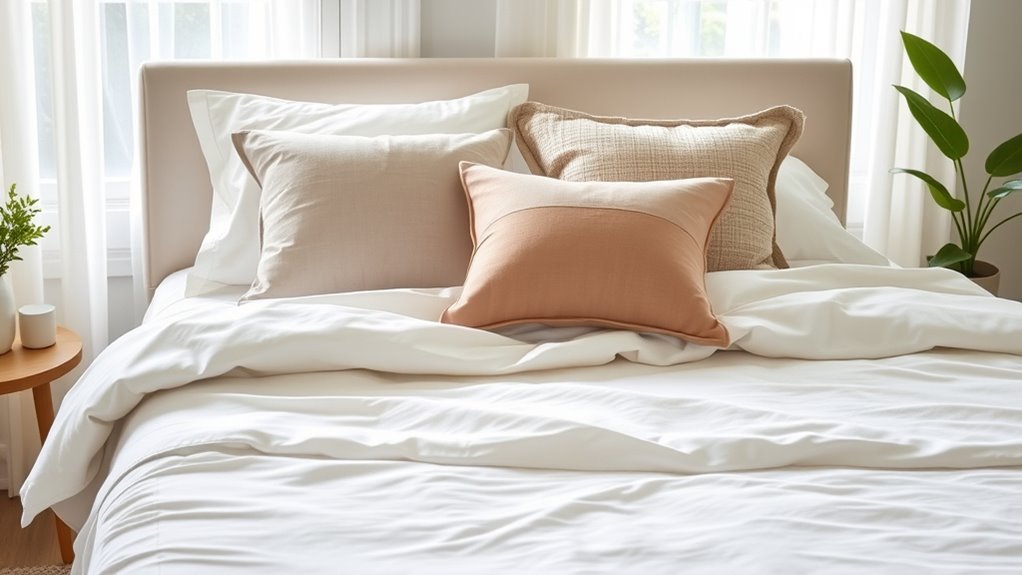
Selecting the right mattress and bedding is essential for minimizing allergens in your bedroom. Opt for hypoallergenic mattresses, which are designed to resist dust mites, mold, and bacteria that can trigger allergies. When choosing bedding, consider organic options made without synthetic chemicals or dyes, as these can irritate sensitive skin and harbor allergens. Look for covers and pillowcases labeled allergen-proof or dust-mite-resistant to create a barrier against common irritants. Regularly washing your bedding in hot water also helps eliminate allergens. By prioritizing hypoallergenic mattresses and organic bedding, you reduce the presence of common bedroom allergens, creating a cleaner, healthier sleep environment that supports your wellness and comfort.
Implementing Effective Cleaning Practices
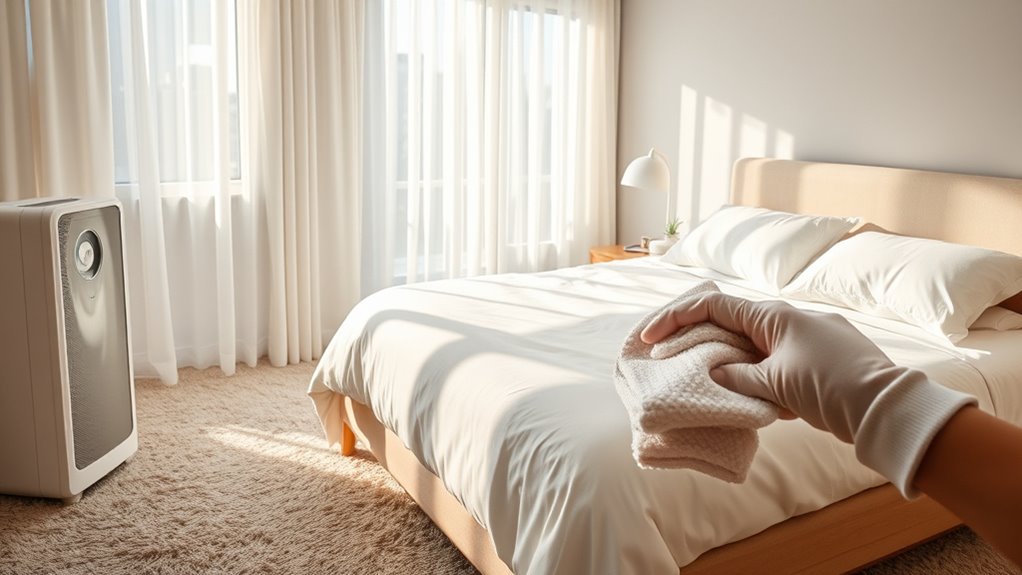
To reduce allergens in your bedroom, make sure to wash your bedding regularly in hot water. Use a HEPA vacuum to thoroughly clean carpets and upholstery, capturing tiny dust particles. Additionally, keep clutter to a minimum to prevent dust from settling and accumulating in hard-to-reach areas.
Regular Bedding Washes
Regularly washing your bedding is one of the most effective ways to reduce allergens in your bedroom. Use hot water, ideally at least 130°F, to kill dust mites and remove allergens effectively. Opt for hypoallergenic bedding whenever possible, as it’s designed to resist dust mites and mold. Consider investing in an allergen-proof mattress cover to prevent allergens from accumulating deep within your mattress. Wash pillows, sheets, and comforters weekly to keep allergens at bay. Using fragrance-free, hypoallergenic detergents minimizes skin irritation and respiratory issues. Make sure to dry your bedding thoroughly, as dampness can promote mold growth. Consistent, effective cleaning of your bedding creates a healthier sleep environment and markedly reduces allergen buildup.
Use HEPA Vacuuming
Using a HEPA vacuum is one of the most effective ways to remove allergens from your bedroom surfaces. HEPA vacuuming captures tiny particles like dust mites, pet dander, and pollen, which can otherwise worsen allergy symptoms. Regularly vacuuming your floors, carpets, and upholstery with a HEPA filter helps improve indoor air quality by preventing allergen buildup. Make sure to vacuum thoroughly in all areas, including under furniture and along baseboards. Using a vacuum with a HEPA filter ensures that allergens are trapped rather than recirculated into the air. This practice not only keeps surfaces cleaner but also considerably reduces airborne allergens, creating a healthier environment. Consistent HEPA vacuuming is a simple yet powerful step toward a more allergen-free bedroom.
Minimize Clutter Accumulation
Clutter can trap dust and allergens, making it harder to keep your bedroom clean and allergen-free. To combat this, focus on smart storage solutions that keep items out of sight and off surfaces. Use bins, shelves, or under-bed storage to reduce visible clutter. Your decor choices matter too—opt for minimalistic designs that don’t invite dust accumulation or become catch-alls for dust-prone items. Regularly sorting and discarding unnecessary belongings prevents dust from settling and keeps your space easier to clean. When clutter is minimized, allergens have fewer places to hide, and cleaning becomes more effective. Implementing these simple strategies helps maintain a tidy, allergen-reduced bedroom environment, supporting your wellness goals effortlessly.
Managing Humidity Levels for Better Air Quality
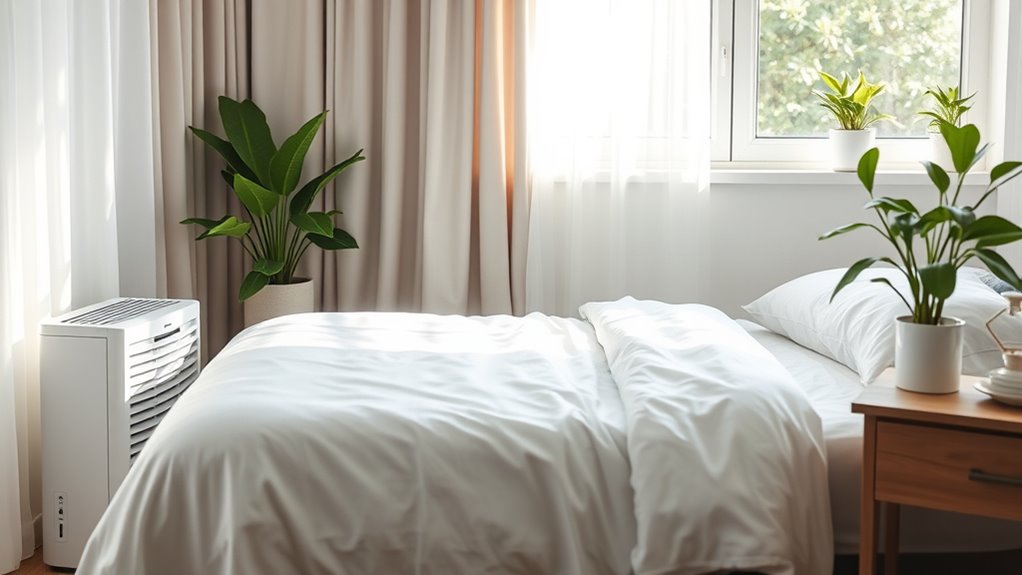
Maintaining the right humidity level in your bedroom is essential for reducing allergens and improving air quality. Proper humidity control helps prevent mold growth, dust mites, and mildew, which thrive in overly moist environments. Aim for a humidity level between 40-50% to create an inhospitable environment for allergens while keeping the air comfortable. Use a hygrometer to monitor moisture levels regularly. If the air is too dry, consider using a humidifier; if it’s too humid, a dehumidifier can help manage excess moisture. Moisture management is vital because high humidity promotes mold and dust mites, while low humidity can cause respiratory irritation. By controlling humidity effectively, you promote a healthier sleeping environment and reduce allergen buildup in your bedroom.
Using Air Purifiers and Ventilation Strategies
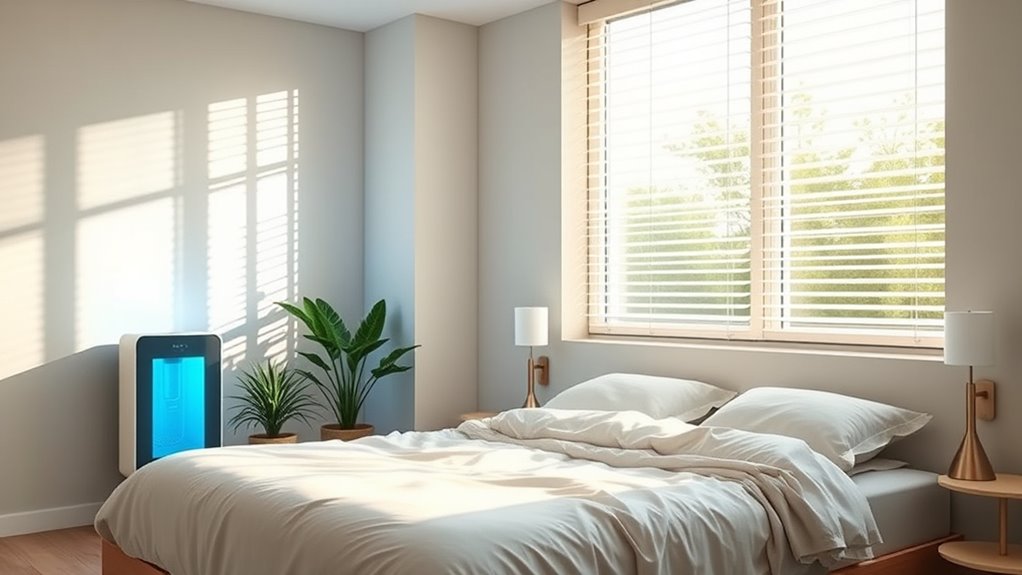
Air purifiers and effective ventilation are key tools for improving indoor air quality and reducing allergens in your bedroom. To maximize their benefits, ensure your air purifier undergoes regular maintenance, like changing filters according to the manufacturer’s instructions. Upgrading your ventilation system can also make a significant difference, providing fresh air and removing indoor pollutants. Consider these strategies:
- Regularly replace or clean air purifier filters
- Use high-efficiency particulate air (HEPA) filters
- Increase airflow with exhaust fans or open windows when feasible
- Install or upgrade ventilation systems for better air exchange
- Schedule routine inspections for ventilation system efficiency
Implementing these steps helps keep airborne allergens at bay, creating a healthier, more comfortable sleeping environment.
Minimizing Dust and Pet Dander
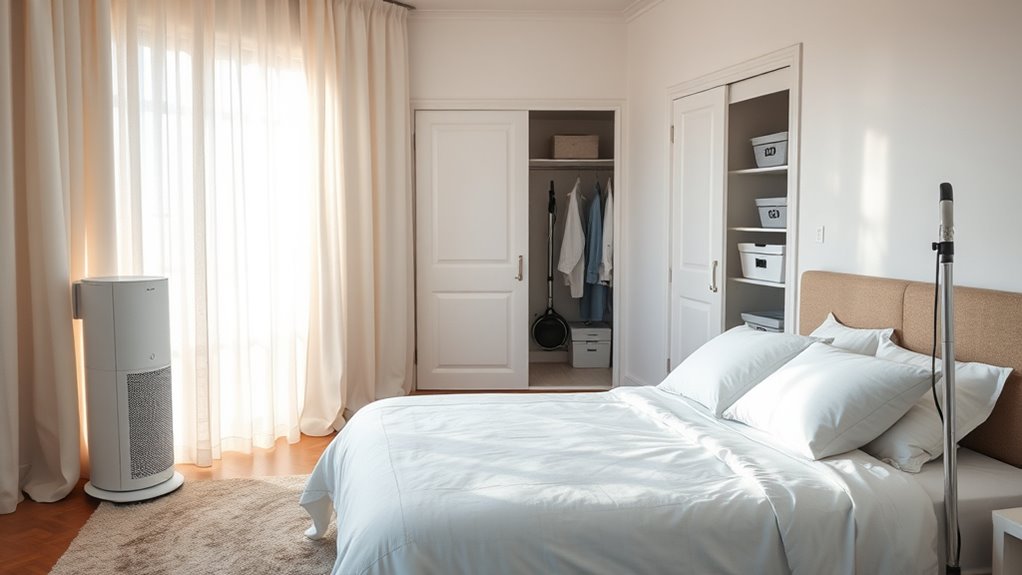
To reduce dust and pet dander, start by laundering your bedding regularly to remove allergens. Using HEPA air purifiers can also help trap airborne particles and improve air quality. Additionally, minimize fabric surfaces in your bedroom, like thick curtains and plush furniture, to limit allergen buildup.
Regular Bedding Laundering
Regularly laundering your bedding is one of the most effective ways to reduce dust and pet dander in your bedroom. Choose a gentle detergent suited for your bedding materials, as some fabrics require special care. Use hot water (130°F or higher) whenever possible, because higher temperatures help eliminate allergens. To maximize results, consider these tips:
- Select a detergent free of fragrances and dyes to prevent irritation
- Wash pillows and comforters regularly, not just sheets
- Use allergen-proof covers on mattresses and pillows
- Opt for bedding materials like tightly woven cotton or hypoallergenic fabrics
- Dry bedding thoroughly on a high heat setting to kill lingering allergens
Consistent laundering keeps allergens at bay, creating a cleaner, healthier sleep environment.
Use HEPA Air Purifiers
Have you considered how a HEPA air purifier can considerably reduce dust and pet dander in your bedroom? These purifiers are highly effective at capturing tiny allergen particles, improving your indoor air quality. To keep your air purifier working efficiently, regular air purifier maintenance is essential—clean or replace filters as recommended. Using allergen proof covers on pillows and mattresses also prevents dust mites from accumulating. Position the purifier in a central location for ideal airflow and avoid obstructing the intake or outflow vents. Consistent use of a HEPA air purifier combined with proper maintenance and allergen proof covers creates a cleaner, healthier environment. This simple step can notably reduce allergy symptoms and enhance your overall sleep quality.
Minimize Fabric Surfaces
Since HEPA air purifiers effectively reduce airborne allergens, addressing fabric surfaces in your bedroom can further cut down on dust and pet dander. Fabric dust tends to settle on soft surfaces, making allergen control more difficult. To minimize this, consider reducing fabric-covered items that trap dust and pet dander. You can:
- Opt for hardwood or tile flooring instead of carpets
- Use washable, allergen-proof covers on pillows and mattresses
- Limit the number of fabric curtains and drapes
- Choose furniture with leather or vinyl upholstery
- Regularly wash bedding, throws, and soft toys in hot water
Creating an Allergen-Resistant Sleep Environment
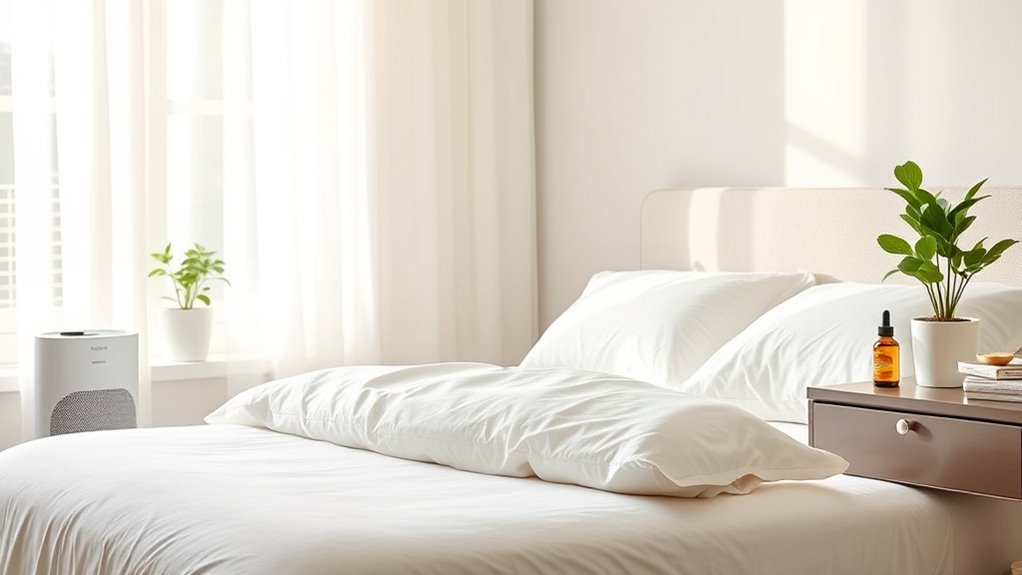
Creating an allergen-resistant sleep environment starts with selecting the right bedding. Choose hypoallergenic mattress and pillow covers to prevent dust mites and pet dander from settling into your sleep surfaces. Your sleep position can influence allergen exposure; sleeping on your back minimizes contact with bedding and dust accumulation. Opt for allergen-proof furniture, such as beds with sealed frames and smooth surfaces, which are easier to clean and less likely to harbor allergens. Keep your bedding clean by washing sheets weekly in hot water. Avoid clutter around your bed to reduce dust collection. Regular vacuuming with a HEPA filter vacuum and dusting hard surfaces also help. These steps create a cleaner, healthier space that supports restful sleep and minimizes allergen exposure.
Incorporating Natural Remedies and Air Fresheners

Incorporating natural remedies and air fresheners can enhance your efforts to reduce bedroom allergens by promoting a fresher, healthier environment. Using natural essential oils and herbal air fresheners helps neutralize odors without introducing synthetic chemicals that may trigger allergies. You can add a few drops of lavender or eucalyptus oil to a diffuser for a calming, allergen-free scent. Herbal air fresheners made from ingredients like chamomile or mint are excellent for freshening your space naturally. To maximize benefits, consider:
- Diffusing natural essential oils regularly
- Creating homemade herbal air fresheners
- Using cotton balls soaked in essential oils
- Placing potted herbs like mint or basil
- Avoiding synthetic, heavily-scented products
These simple steps promote a cleaner, allergen-reduced bedroom environment.
Maintaining Consistent Wellness Habits for Long-Term Relief
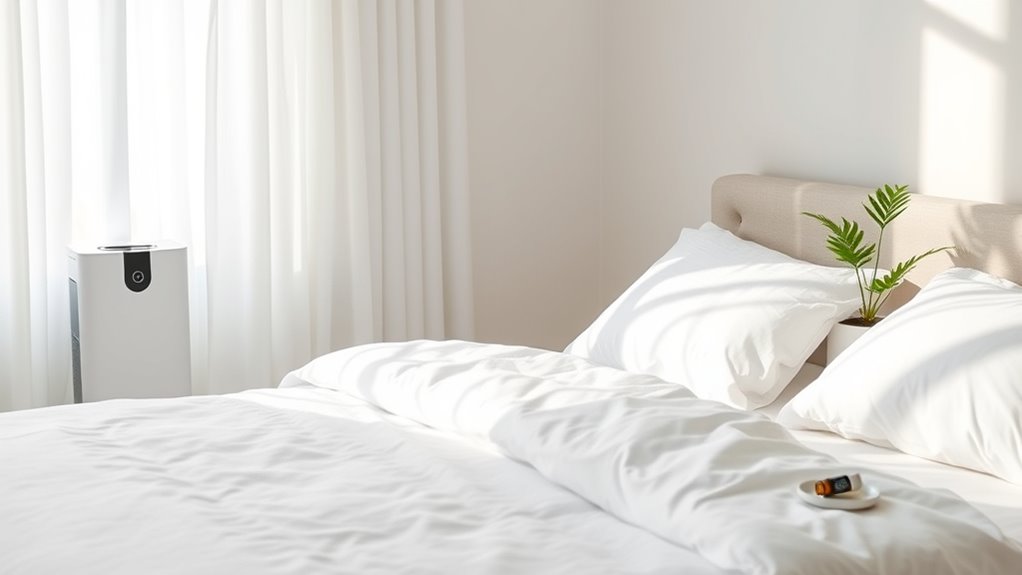
Maintaining consistent wellness habits is essential for achieving long-term relief from bedroom allergens. Incorporate mindful breathing into your daily routine to help manage stress and improve your overall well-being. When you focus on deep, intentional breaths, you lower stress levels, which can strengthen your immune system and reduce allergic reactions. Regular stress reduction techniques, like meditation or gentle stretching, support your efforts by preventing stress from weakening your defenses. Staying consistent with these habits ensures your body remains resilient against allergens and creates a healthier environment. Over time, this proactive approach not only minimizes allergy symptoms but also promotes a sense of calm and balance, making it easier to maintain a cleaner, allergen-reduced bedroom.
Frequently Asked Questions
How Do I Identify Hidden Allergens in My Bedroom?
You can identify hidden allergens in your bedroom by inspecting common trouble spots. Look for dust mites in bedding, pillows, and mattress seams, and check for pet dander on furniture and carpets. Use allergen test kits or consult an allergist for thorough testing. Regularly clean and vacuum with a HEPA filter to spot and reduce dust mites and pet dander, making your space safer and more comfortable.
Can Certain Plants Improve Bedroom Air Quality Naturally?
Plants can perfectly purify your bedroom air, especially beneficial houseplants that boost brightness and breathe fresh life. While indoor air purifiers work wonders, certain plants like snake plants and peace lilies naturally filter pollutants and improve air quality. These beneficial houseplants can help create a cleaner, calmer environment, combining natural beauty with health benefits. So, add some greenery, and let nature nurture your night’s restful, allergen-free air.
What Are the Best Hypoallergenic Materials for Curtains and Decor?
For allergen-resistant decor, choose curtains and decor made from hypoallergenic fabrics like tightly woven cotton, bamboo, or microfiber. These materials resist dust mites and reduce allergen buildup, helping you breathe easier. Avoid heavy, plush fabrics that trap allergens. Opt for smooth, washable surfaces and regularly clean with a HEPA vacuum to keep your space allergen-free. This approach creates a healthier, more comfortable bedroom environment.
How Often Should I Replace My Air Filters for Optimal Allergy Control?
If you want to keep allergens at bay, don’t ignore air filter maintenance. Typically, you should replace your filters every 1 to 3 months, but this varies with allergen detection techniques—if you notice increased dust or sneezing, it’s time. Regular changes guarantee ideal airflow and allergen removal, preventing buildup that could worsen allergy symptoms. Stay vigilant, and your bedroom will remain a sanctuary free of unseen irritants.
Are There Specific Sleep Positions That Reduce Allergy Symptoms?
You should try sleeping in a position that keeps your head elevated, like on a pillow, to improve airflow and reduce allergy symptoms. Avoid sleeping on your stomach, which can restrict breathing. Incorporate breathing techniques such as deep, slow breaths to ease nasal congestion. Your sleep posture and mindful breathing can help minimize allergy flare-ups, making your nights more comfortable and your mornings clearer.
Conclusion
Just like a well-tuned orchestra creates harmony, maintaining a healthy bedroom environment guarantees peaceful, allergen-free sleep. By staying vigilant—like a watchful guardian—you’ll transform your space into a sanctuary of comfort. Remember, small consistent actions, much like the gentle ripples in a pond, lead to long-term relief. Embrace these tips, and soon your bedroom will be a haven, echoing the serenity of a quiet lake at dawn.
